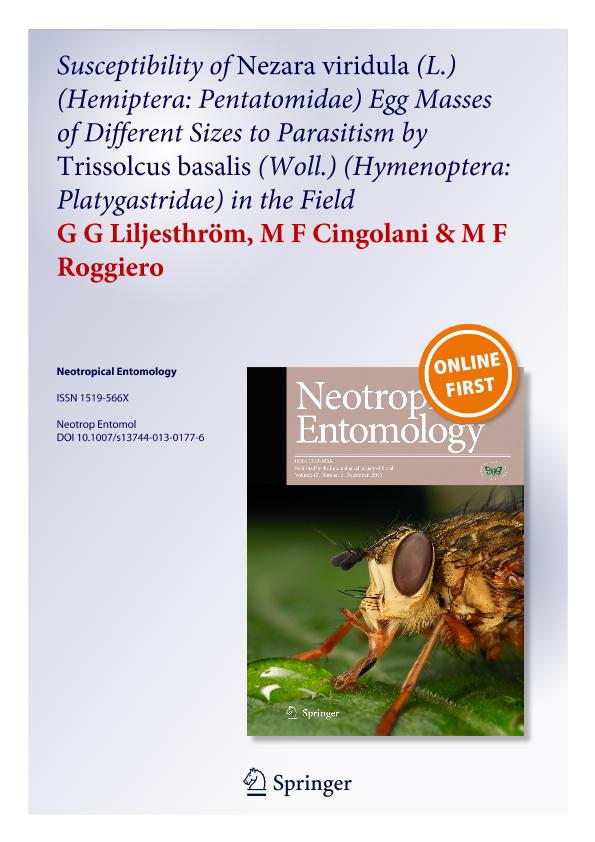Mostrar el registro sencillo del ítem
dc.contributor.author
Liljesthrom, Gerardo Gustavo

dc.contributor.author
Cingolani, Maria Fernanda

dc.contributor.author
Roggiero, Martha Florencia

dc.date.available
2016-12-15T21:53:05Z
dc.date.issued
2013-11
dc.identifier.citation
Liljesthrom, Gerardo Gustavo; Cingolani, Maria Fernanda; Roggiero, Martha Florencia; Susceptibility of Nezara Viridula (L.) (Hemiptera: Pentatomidae) egg masses of different sizes to parasitism by Trissolcus Basalis (Woll.) (Hymenoptera: Platygastridae) in the field; Sociedade Entomológica Do Brasil; Neotropical Entomology; 43; 11-2013; 78-84
dc.identifier.issn
1519-566X
dc.identifier.uri
http://hdl.handle.net/11336/9552
dc.description.abstract
Egg masses of Nezara viridula (L.) are commonly parasitized by Trissolcus basalis (Woll.), and we investigated the role of size of egg masses on parasitization by T. basalis. Sentinel egg masses were exposed to parasitism in the field for 6–7 days, when they were collected for evaluation of parasitoid emergence. We recorded the number of eggs per egg mass, the number of emerged hosts, and the number of empty and parasitized eggs. We calculated the proportion of attacked host egg masses (DE), the proportion of parasitized eggs per attacked egg mass (PE), and total parasitism (PI). The total number of egg masses exposed to parasitism was 330. The minimum, mean, and maximum egg mass sizes were 25, 75.2, and 111, respectively. DE and PE varied widely between different fields, and they were independent of egg mass size. In 14.2% of all parasitized egg masses, we found simultaneous emergence of T. basalis and N. viridula independently of host egg mass size. PE exhibited low variability compared with PI and DE, which were linearly related. PI and DE values from other field studies are consistent with the linear relationship, suggesting that PI is mostly related to the proportion of the DE. This also suggests that total parasitism is independent of egg mass size, of possible differences in plant species, and T. basalis density and strains.
dc.format
application/pdf
dc.language.iso
eng
dc.publisher
Sociedade Entomológica Do Brasil

dc.rights
info:eu-repo/semantics/openAccess
dc.rights.uri
https://creativecommons.org/licenses/by-nc-sa/2.5/ar/
dc.subject
Stink Bug
dc.subject
Egg Mass Size
dc.subject
Egg Parasitoids
dc.subject
Field Parasitism
dc.subject.classification
Ecología

dc.subject.classification
Ciencias Biológicas

dc.subject.classification
CIENCIAS NATURALES Y EXACTAS

dc.title
Susceptibility of Nezara Viridula (L.) (Hemiptera: Pentatomidae) egg masses of different sizes to parasitism by Trissolcus Basalis (Woll.) (Hymenoptera: Platygastridae) in the field
dc.type
info:eu-repo/semantics/article
dc.type
info:ar-repo/semantics/artículo
dc.type
info:eu-repo/semantics/publishedVersion
dc.date.updated
2016-12-12T14:19:08Z
dc.identifier.eissn
1678-8052
dc.journal.volume
43
dc.journal.pagination
78-84
dc.journal.pais
Brasil

dc.description.fil
Fil: Liljesthrom, Gerardo Gustavo. Consejo Nacional de Investigaciones Científicas y Técnicas. Centro Científico Tecnológico la Plata. Centro de Estudios Parasitológicos y de Vectores (i); Argentina
dc.description.fil
Fil: Cingolani, Maria Fernanda. Consejo Nacional de Investigaciones Científicas y Técnicas. Centro Científico Tecnológico la Plata. Centro de Estudios Parasitológicos y de Vectores (i); Argentina
dc.description.fil
Fil: Roggiero, Martha Florencia. Consejo Nacional de Investigaciones Científicas y Técnicas. Centro Científico Tecnológico la Plata. Centro de Estudios Parasitológicos y de Vectores (i); Argentina
dc.journal.title
Neotropical Entomology

dc.relation.alternativeid
info:eu-repo/semantics/altIdentifier/doi/http://dx.doi.org/10.1007/s13744-013-0177-6
Archivos asociados
